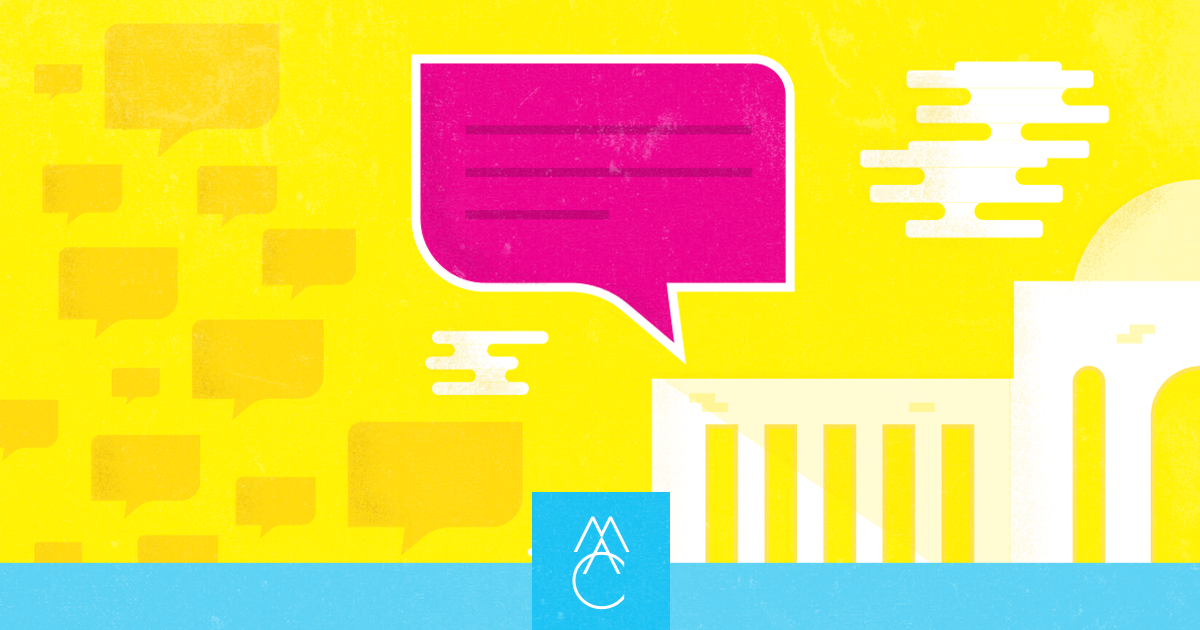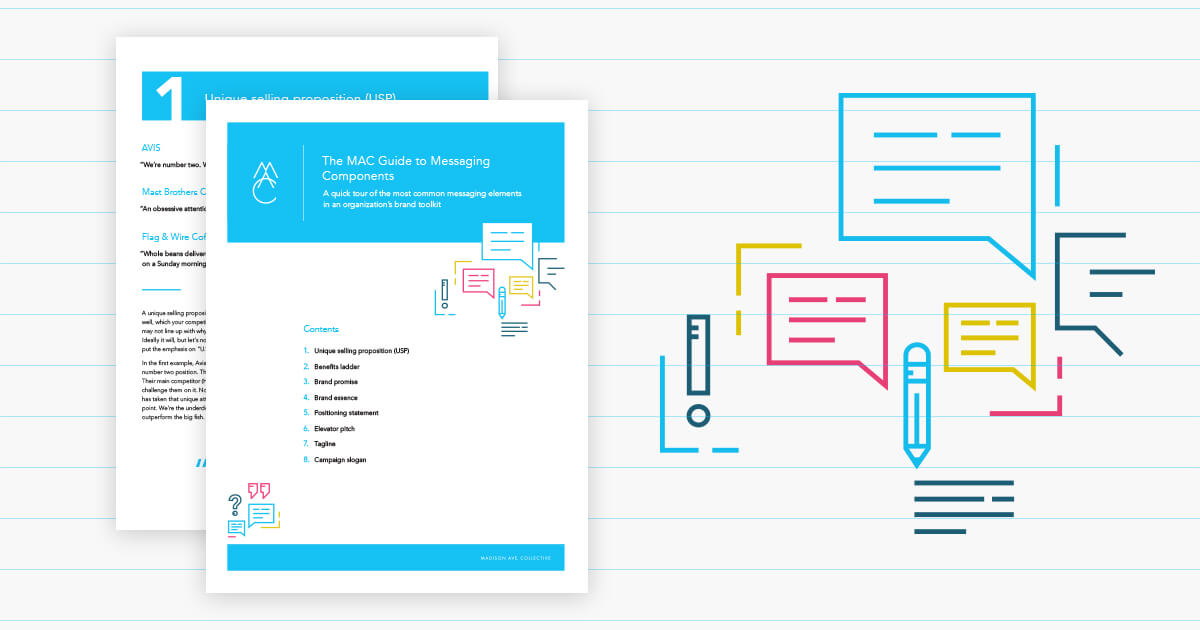
Taglines, slogans, and other messaging: New rules for differentiation in higher ed
More than just words
Whether it’s a tagline or a slogan, a motto, or a mantra, the rules are the same. Effective communication starts with knowing who you are — what your mission and vision are, and where your strategic plan says you want to go. Differentiation is, after all, about being different. And touting your differences will, when done correctly, attract the right kinds of prospective students and donors while causing others to look elsewhere. And that’s the whole point. Institutions of higher education cannot be all things for all people, nor should they try to be.
Slogans vs. taglines: What’s the difference?
It’s easy to be confused about the difference between slogans and taglines, so let’s sort this out up front. The two have similar, but distinct roles to play in marketing and differentiation.
A slogan is a catchphrase — a short string of words designed to catch people’s attention. It’s a hook. It’s something you can lead a marketing campaign with. Effective slogans are casual, memorable, repeatable in conversation, and sometimes they even get turned into musical jingles. Repetition, rhyme, or alliteration help make slogans memorable and easy to say.
Slogans can also be thought of as battle cries, often used skillfully by higher ed athletic departments to rally fans (and to sell tickets). Ideally, a slogan will cause people to feel something — hope, belonging, school pride, or whatever emotional quality you want associated with your brand.
A tagline, on the other hand, is something that’s tagged on at the end. Taglines are commonly placed after or below a logo or, say, at the bottom of a marketing brochure. Taglines are designed to be read (not said). You read the name of the organization first, then you read the tagline. Always in that order. Taglines are supposed to provide context or additional meaning to the brand name, and are particularly useful when introducing new entities into the world. Taglines can be derived from mission statements or brand promises, and, therefore, will live much longer than shorter-term campaign slogans.
While a good tagline might evoke an emotional response, it must first be functional: it should summarize your story, your purpose, or speak to the unique and specific benefits you offer.
Both slogans and taglines are messaging tools that can be used to differentiate an organization, but sometimes it’s hard to tell the difference between the two. Here’s a simple test: You know you’ve got a slogan if it’s able to work alone, with or without your logo. Otherwise, if the words are only meaningful when combined with your logo, you’ve got a tagline.
Not to purposely confuse things, but it’s worth pointing out that some taglines morph into slogans over time. This doesn’t happen often, but it’s possible for a tagline to become familiar enough that it starts to become useful on its own.
If it’s not different, you’re not different
Because most colleges and universities have long, established histories and are well known either regionally or nationally, they usually don’t need — and probably shouldn’t have — a formal tagline attached to their logo. While slogans can be quite useful for specific marketing campaigns (capital fundraising, new student enrollment, etc.), taglines for higher ed institutions are typically pointless. Especially if the tagline does nothing to differentiate from the 4,000 other colleges and universities in the U.S.

Take “Your Future, Our Focus” for example. It’s the tagline of Northern Illinois University, prominently displayed in bright red and placed directly below their name, just as any proper tagline should be. The problem is, another college in Wyoming uses the exact same four words for their statement of differentiation. This tagline also happens to be used by an attorney in Milwaukee, a career center in Ohio, and a wealth management firm in Scottsdale. I stopped Googling there, but you get the point.
“Imagine More” and “Inspiring People” are other great examples of higher ed taglines that are utterly and completely undifferentiated.
So what’s an effective tagline for higher ed look like? Columbia University’s “In the City of New York” does an excellent job differentiating itself from competitors. How so? For one, Columbia is the only Ivy League university located in NYC — a distinct benefit for prospective students looking for the big city experience. Brown and Princeton can’t offer that. “In the City of New York” also differentiates Columbia University from the other Columbias in Hollywood, Salt Lake City, and Chicago. There is, after all, only one Columbia in the city of New York.
Remember, taglines don’t need to be provocative to be effective. Columbia’s tagline works because it’s functional. It’s not clever, but it’s crystal clear.
Make it meaningful
For any communication marketing to work, the words you choose must personally be meaningful to the individual you’re trying to reach. Otherwise, what you’re saying won’t be heard, won’t be remembered, and won’t be acted upon. Meaningful messaging, when done right, will cement the bond between your program and your people. And when enough people embrace your message it can suddenly take on a life of its own.
The University of Kentucky’s “See Blue.” campaign is the perfect case study for a meaningful and memorable slogan that continues to pay off nine years after its debut. Yes, it’s won regional and national awards, but that’s not what makes it great. We know “See Blue.” is working for UK because people love it. And people love it because it’s meaningful to them. They own it. In fact, the UK community chose the slogan after being presented with options by the university’s marketing department. (This, following a long period of research into what students, staff, alumni, and other supporters value, and why UK is special to them.)

“The campus has bought into it. “See Blue.” has taken on a life of its own. I think it may be something that’s here with us forever.” — Kelly Bozeman, Director of Marketing at the University of Kentucky, in an interview with WUKY Radio.
And then there’s the University of Oregon’s “If” campaign. What initially was pegged for a $20 million branding spend, the school’s leadership recently pulled the plug after burning the first $5 million on some highly-polished marketing collateral and this video. What went wrong? The university-wide community never got on board. Unlike at UK, the University of Oregon’s people weren’t invested and they didn’t have a sense of ownership over the message. The work was beautiful, but it wasn’t meaningful.
Get everyone involved
Developing meaningful, differentiated messaging is a team sport. It’s critical that you get early buy-in from your school’s leadership — especially your president or chancellor — as well as from staff, students, alumni, and the university community at large. Test your messaging, float ideas for feedback, and involve the people who care the most about your brand.
And while there’s certainly wisdom in investing appropriate resources to spread your message around, when you start to see students printing the words on their graduation caps you know you’ve got yourself a winner.
This article is also published on Medium.
More Resources
-

Article
How to build a higher ed website that achieves excellenceIt’s one thing to deliver an excellent student experience on campus; quite another to build an excellent website. Between us...
-

eBook
MAC Guide to Messaging ComponentsFrom positioning statements to elevator pitches to taglines, here are eight messaging elements you can use to define and promote...
-

Article
A better way to brand and market online degreesUniversities coast-to-coast are offering an ever-increasing number of degrees and certificates online these days (craft brewing or turf grass management,...



